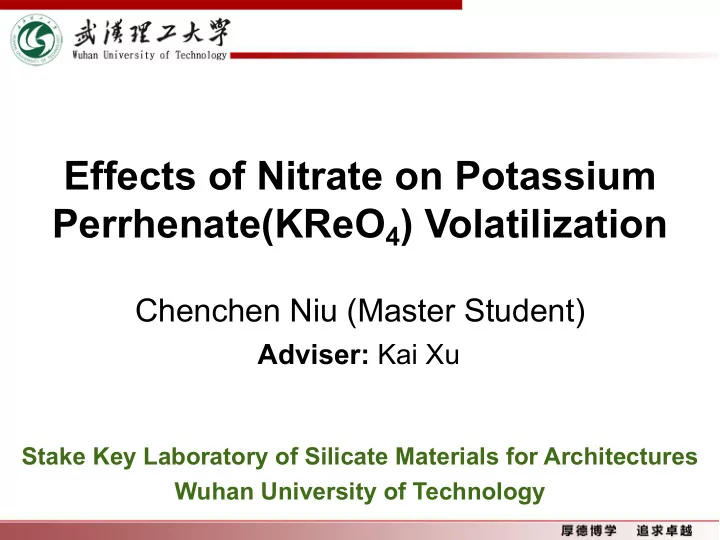

Effects of Nitrate on Potassium Perrhenate(KReO 4 ) Volatilization Chenchen Niu (Master Student) Adviser: Kai Xu Stake Key Laboratory of Silicate Materials for Architectures Wuhan University of Technology
Outline p Background p Experimental p Results and Discussion p The path of Tc/Re volatilization p The effect of nitrate- at low temperature p The effect of nitrate- at high temperature p Conclusion
Background- The concern of Tc Tc-99 l Long half-life: 2.1 × 10 5 years l High yield: 6.1% ( 235 U fission ) Tc l High solubility and mobility of TcO 4- (the dominant species) Re: as a nonradioactive surrogate Tc pathway during the process of nuclear waste vitrification Decrease waste loading (100-x)% Tc recycled (also contain S, Cl, Na, etc.) (100-x)% Tc Off-gas Tc-contained Melter system waste 100% Tc x% Tc (x: 10-80) To waste glass
Background- Effect factors on Tc/Re volatilization Redox Measured single-pass Tc retentions for seven waste glass formulations with and without ferrous oxalate Tc retention almost increases with the addition of reductant Pegg, Ian L. "Behavior of technetium in nuclear waste vitrification processes." Journal of radioanalytical and nuclear chemistry 305.1 (2015): 287-292.
Background- Effect factors on Tc/Re volatilization Inorganic Salt Single-pass retention (%) Waste Tc Re AP-101 18 25 AN-105 34 43 AN-107 31 39 AN-104 20 36 AN-102 19 27 AZ-101 36 NA AZ-102 66 57 Pegg et al ., VSL-10R1920-1 (2010) Pegg et al ., VSL-11R2260-1 (2011) Kim et al ., JNCS (2015); Xu et al ., JNM (2015) Tc/Re shows different volatility in different kinds of waste glass feeds
Background- Effect factors on Tc/Re volatilization Inorganic Salt AN-102 (Hanford site) AN-103 (Hanford site) Compositions of the feed of the AN-102 and AN-103 samples Nuclear waste contains various inorganic salts (nitrates/nitrites, chlorides, sulfates)
Background- Effect factors on Tc/Re volatilization Inorganic Salt Reaction and foaming layer in Cold-cap Evolved gas composition and volume expansion T ≈ 100 o C Tc dissolved in mixed Reaction molten salt layer T ≈ 800 o C Tc dissolved Foaming in glass melt layer T ≈ 1070 o C Elemental retention 100 ℃ 700 ℃ 1000 ℃ Decomposition of inorganic salt occurred in the Cl 67 56 49 reaction layer of cold-cap, which affect Tc/Re S 100 72 48 retention, however, the detail is not clear Re 100 94 93 Xu et al ., JACerS (2015), (2016); Dixon et al ., EST (2015) J.G Darab, E.M Meiers, A.P Smith; Mater. Res. Soc. Proc., 556 (1999), p. 215
Background- The argument of Tc/Re volatilization path Congruent evaporation of MTcO 4 melt MTcO 4 (s/l) → MTcO 4 (g) Decomposition of MTcO 4 melt 2MTcO 4 (l) → Tc 2 O 7 (g) + M 2 O (s/l/g) Migge H. Simultaneous Evaporation of Cs and Tc during Vitrification-A Thermochemical Approach [J]. Materials Research Society Symposium Proceedings, 1990, 176: 411-417. Kim D S, Soderquist C Z, Icenhower J P, et al . Tc Reductant Chemistry and Crucible Melting Studies with Simulated Hanford Low-Activity Waste, PNNL-15131 [R]. Richland, WA, US: Pacific Northwest National Laboratory, 2005.
Motivation • The Tc/Re volatilization path • Effects of nitrate on KReO 4 volatilization
Experimental Crucible test Micro-test Sample Total/g Pure Re 2 TG-DSC Pure N 2 1Re4N 2 GC-MS 1Re2N 2 1Re1N 2 1Re0.5N 2 1Re0.25N 2 From RT to Muffle 500~1300 ℃ at the rate of furnace 5 ℃ /min (interval: 100 ℃ ) Cooling Mass loss XRD XRF, CHNS/O
Results & Discussion- The Tc/Re volatilization path Mass loss 100 Retention of Re and K(%) Re 80 K 60 2Theta 40 XRD 20 0 700 800 900 1000 1100 1200 o C) T ( XRF
Results & Discussion- The effect of nitrate High temperature zone Low temperature zone
Results & Discussion- The effect of nitrate-at low temperature Mass loss XRD semi-quantitative analysis Mass loss of mixed samples and pure N 1. With increase of N ratio, mass loss in mixed samples is closer to that of pure N 2. No new phases are formed at low temperatures
Results & Discussion- The effect of nitrate-at high temperature XRD semi-quantitative analysis Mass loss Mass loss of mixed samples at high temperature zone 1. The mass loss in mixed samples at temperature above 1000 ℃ is higher than pure N, but lower than pure Re 2. Amorphous phase appear at high temperature zone
Results & Discussion- The effect of nitrate-at high temperature Re retention 1300 ℃ 12 10 Re retention 8 6 4 2 0 Pure Re 1Re0.25N 1Re0.5N 1Re 1N 1Re2N 1Re4N 1. At 1300 ℃ , Re still retained in the mixed samples, whereas all Re was gone in pure Re 2. At 1300 ℃ , Re retention in mixed samples increases with the increase of N ratio
Conclusion
Thanks for your attention
Recommend
More recommend